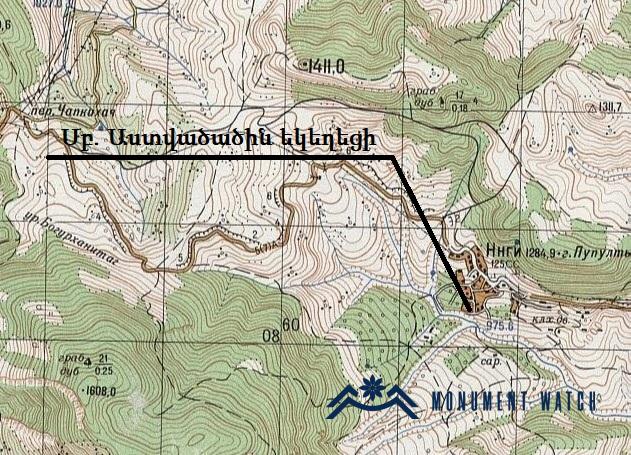The Surb Astvatsatsin Church of Nngi village
Historical overview
According to the construction inscription on the main entrance of the church, it was built in 1858 (Fig. 3). The church is mentioned by Makar Barkhudaryants: "...the church of the Surb Astvatsatsin, stone-built, built on four pillars" (Barkhutareants 1895, p. 126). On the porch of the church, located to the west, the building inscription and a rhyming inscription have been preserved, where all the lines end with a separate Ի (Vyun) capital letter.
"This house is blessed with light
For the young and old of Nngi village.
Our ancestors, with hope in their hearts,
Left this as a keepsake for future generations.
Remember us in your prayers
As you gather for the liturgy.
In the summer of 1858."
There may have been an older shrine or another church on the site of the current church. Khachkars and tombstones are built into the church walls. A khachkar from the 13th century is placed on one of the pillars of the church (Fig. 4), and atop another pillar (Fig. 5), there is a carved stone with a commemorative inscription from the 19th century: "1888 / Ter Paghdasar, / Ter Petros, / Ter ..., / Ter Sargis." Khachkars are especially numerous in the tabernacle area (Fig. 6).
On the western side of the church, there is a khachkar from the 12th century (Fig. 7) with the following inscription: "God, have mercy on the soul of Tamama. Worshipers of the cross, remember priest Grigor. Year 633 (1184)."
The volume of the “Corpus of Armenian Epigraphy” dedicated to Artsakh mentions a tombstone installed outside the eastern wall of the church, with the following inscription: "This is the grave of Sazpand Mirza, son of Mur, year 1226 (1777)" (CAE 5, 158).
Another khachkar with an inscription is built above the window on the south side of the church, bearing the inscription: "Year 972 (1523). Agha Mar..." (CAE 5, 158).
Architectural-compositional examination
The church is a vaulted hall that is divided into three naves by two pairs of vaulted columns. The arches and vault have an arrow-shaped volume.
Externally, it is constructed with rough, large, and hollow stones of limestone and sandstone. The corners of the structure, the porch, and the curbstones of the windows are polished (Fig. 8). The gable roof is now covered with galvanized sheet metal.
The interior features plastered walls and polished stone vault-bearing columns. The high altar platform, arches, and the hall are finely crafted. A baptismal font is located near the stage on the north wall. Overall, this church in Artsakh is a prime example of 19th-century architecture and construction artistry.
The condition before and after the war
The church was not damaged during the Artsakh wars, even though the village was bombed during the 44-day war in 2020. It has since been repaired, as evidenced by a plaque on the west wall. During the renovation, a small belfry was installed on the roof.
Bibliography
Barkhutareants 1895 - Barkhutareants M., Artsakh, Baku.
CAE 5 - Corpus of Armenian Epigraphy, issue 5, Artsakh/ made by S. Barkhudaryan, Yerevan, 1982.
The Surb Astvatsatsin Church of Nngi village
Artsakh








